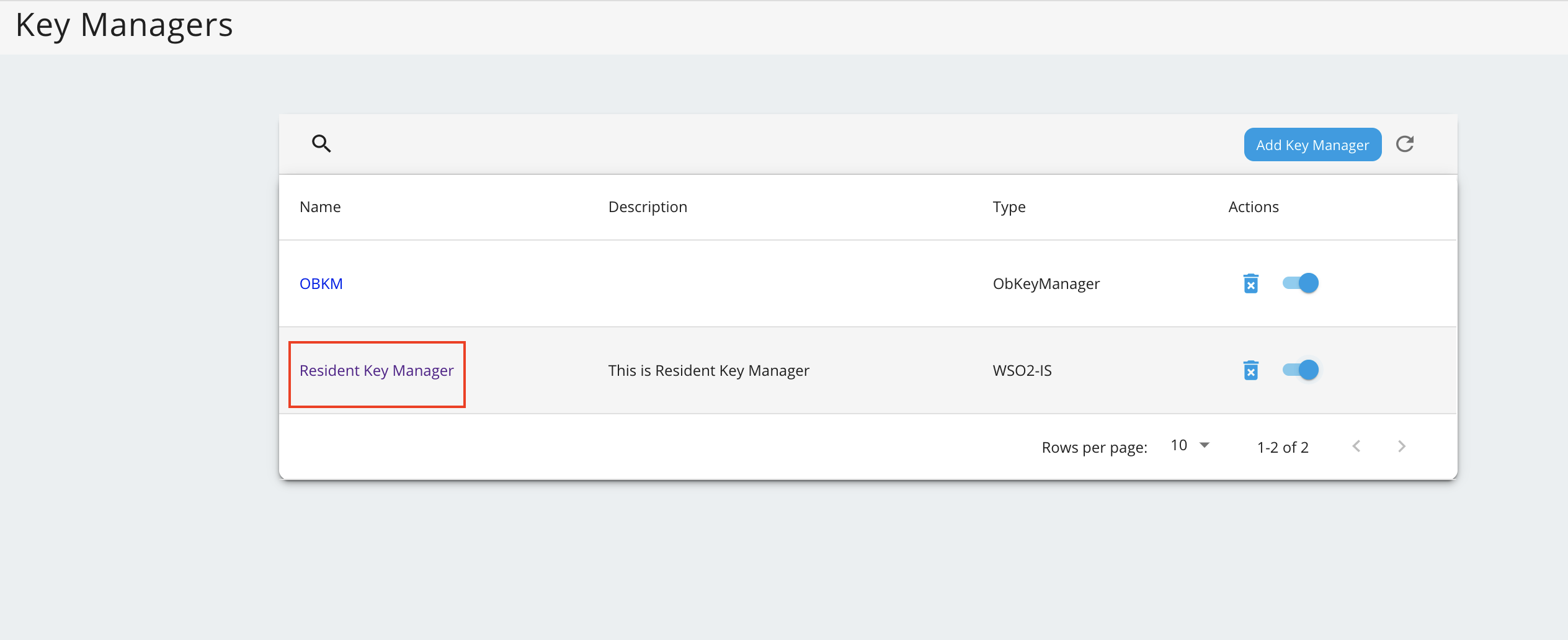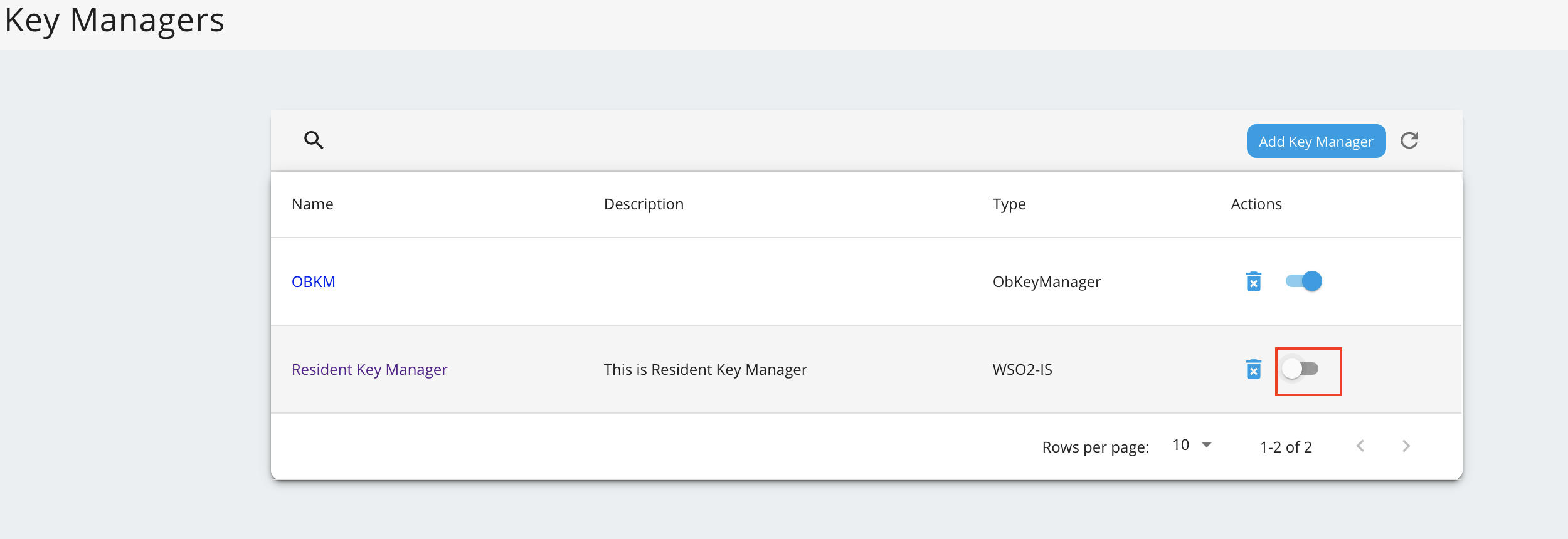Configuring API Manager
WSO2 Open Banking Accelerator contains TOML-based configurations. All the server-level configurations of the
API Manager instance can be applied using a single configuration file, which is the deployment.toml file.
Configuring deployment.toml¶
Follow the steps below to configure the deployment.toml file and set up the default open banking flow for WSO2 API
Manager.
Tip
If you want to customize and learn more about TOML configurations, see API Manager Configuration Catalog for open banking.
-
Replace the
deployment.tomlfile as explained in the Setting up the servers section. -
Open the
<APIM_HOME>/repository/conf/deployment.tomlfile. -
Set the hostname of the API Manager:
[server] hostname = "<APIM_HOST>" -
Update the datasource configurations with your database properties, such as the username, password, JDBC URL for the database server, and the JDBC driver.
- Given below are sample configurations for a MySQL database. For other DBMS types and more information, see Setting up databases.
[database.shared_db] url = "jdbc:mysql://localhost:3306/openbank_govdb?autoReconnect=true&useSSL=false" username = "root" password = "root" driver = "com.mysql.jdbc.Driver"[database.apim_db] url = "jdbc:mysql://localhost:3306/openbank_apimgtdb?autoReconnect=true&useSSL=false" username = "root" password = "root" driver = "com.mysql.jdbc.Driver"[database.config] url = "jdbc:mysql://localhost:3306/openbank_am_configdb?autoReconnect=true&useSSL=false" username = "root" password = "root" driver = "com.mysql.jdbc.Driver"[[datasource]] id="WSO2UM_DB" url = "jdbc:mysql://localhost:3306/openbank_userdb?autoReconnect=true&useSSL=false" username = "root" password = "root" driver = "com.mysql.jdbc.Driver" -
Update the following configurations with the hostname of the Identity Server.
[apim.key_manager] service_url = "https://<IS_HOST>:9446${carbon.context}services/"[apim.key_manager.configuration] ServerURL = "https://<IS_HOST>:9446${carbon.context}services/"[open_banking.dcr] #jwks_endpoint_name = "" #app_name_claim = " " token_endpoint = https://<APIM_HOST>:9443/oauth2/token -
Add the following and configure the hostname of the Identity Server.
[open_banking.gateway.consent.validation] endpoint = "https://<IS_HOST>:9446/api/openbanking/consent/validate" -
Add the following gateway executor configurations for the Consent flow:
[[open_banking.gateway.openbanking_gateway_executors.type]] name = "Consent" [[open_banking.gateway.openbanking_gateway_executors.type.executors]] name = "com.wso2.openbanking.accelerator.gateway.executor.impl.selfcare.portal.UserPermissionValidationExecutor" priority = 1 -
Add the following tags and configure the HTTP connection pool:
Info
This is only available as a WSO2 Update from WSO2 Open Banking API Manager Accelerator Level 3.0.0.7 and WSO2 Open Banking Identity Server Accelerator Level 3.0.0.10 onwards. For more information on updating, see Getting WSO2 Updates.
[open_banking.http_connection_pool] max_connections = 2000 max_connections_per_route = 1500 -
If you want to use the Data publishing feature:
- Enable the feature and configure the
server_urlproperty with the hostname of WSO2 Streaming Integrator.
[open_banking.data_publishing] enable = true username="$ref{super_admin.username}@carbon.super" password="$ref{super_admin.password}" server_url = "{tcp://<SI_HOST>:7612}" - Enable the feature and configure the
-
If you are using WSO2 API Manager 4.2.0, you need to change the API Manager REST API version from V2 to V3.
- Locate the
[open_banking.dcr.apim_rest_endpoints]tag. By default, the configuration is commented out. - Uncomment the configuration and update as shown below:
[open_banking.dcr.apim_rest_endpoints] app_creation = "api/am/devportal/v3/applications" key_generation = "api/am/devportal/v3/applications/application-id/map-keys" api_retrieve = "api/am/devportal/v3/apis" api_subscribe = "api/am/devportal/v3/subscriptions/multiple" retrieve_subscribe="api/am/devportal/v3/subscriptions"
- Locate the
Starting servers¶
-
Go to the
<APIM_HOME>/bindirectory using a terminal. -
Run the
wso2server.shscript as follows:./api-manager.sh
Configure Identity Server as Key Manager¶
The Key Manager handles all clients, security, and access token-related operations. In a typical API Manager production deployment, different components talk to the Key Manager component to achieve different tasks.
This section explains how to configure WSO2 Identity Server as the Key Manager for WSO2 API Manager.
-
Sign in to the Admin Portal of API Manager at
https://<APIM_HOST>:9443/admin. -
Go to Key Manager on the left main menu.

-
Click Add New Key Manager and configure Key Manager.
Click here to see the full list of configurations...
Configuration Description Value Name The name of the authorization server. OBKM Display Name A name to display on the UI. OBKM Description The name of the authorization server. (Optional) Key Manager Type The type of the Key Manager to be selected. Select ObKeyManagerWell-known-url The well-known URL of the authorization server (Key Manager). https://<IS_HOST>:9446/oauth2/token/.well-known/openid-configurationIssuer The issuer that consumes or validates access tokens. https://<IS_HOST>:9446/oauth2/tokenKey Manager Endpoints Client Registration Endpoint The endpoint that verifies the identity and obtain profile information of the end-user based on the authentication performed by an authorization server. https://<IS_HOST>:9446/keymanager-operations/dcr/registerIntrospection Endpoint The endpoint that allows authorized protected resources to query the authorization server to determine the set of metadata for a given token that was presented to them by an OAuth Client. https://<IS_HOST>:9446/oauth2/introspectToken Endpoint The endpoint that issues the access tokens. https://<IS_HOST>:9446/oauth2/tokenRevoke Endpoint The endpoint that revokes the access tokens. https://<IS_HOST>:9446/oauth2/revokeUserinfo Endpoint The endpoint that allows clients to verify the identity of the end-user based on the authentication performed by an authorization server, as well as to obtain basic profile information about the end-user. https://<IS_HOST>:9446/oauth2/userinfo?schema=openidAuthorize Endpoint The endpoint used to obtain an authorization grant from the resource owner via the user-agent redirection. https://<IS_HOST>:9446/oauth2/authorizeScope Management Endpoint The endpoint used to manage the scopes. https://<IS_HOST>:9446/api/identity/oauth2/v1.0/scopesConnector Configurations Username The username of an admin user who is authorized to connect to the authorization server. Password The password corresponding to the latter mentioned admin user who is authorized to connect to the authorization server. Claim URIs Consumer Key Claim URI The claim URI for the consumer key. (Optional) Scopes Claim URI The claim URI for the scopes (Optional) Grant Types The supported grant types. Add multiple grant types by adding a grant type press Enter. (Optional) Certificates PEM Either copy and paste the certificate in PEM format or upload the PEM file. (Optional) JWKS The JSON Web Key Set (JWKS) endpoint is a read-only endpoint. This URL returns the Identity Server's public key set in JSON web key set format. This contains the signing key(s) the Relying Party (RP) uses to validate signatures from the Identity Server. https://<IS_HOST>:9446/oauth2/jwksAdvanced Configurations Token Generation This enables token generation via the authorization server. (Mandatory) Out Of Band Provisioning This enables the provisioning of Auth clients that have been created without the use of the Developer Portal, such as previously created Auth clients. (Mandatory) Oauth App Creation This enables the creation of Auth clients. (Mandatory) Token Validation Method The method used to validate the JWT signature. Self Validate JWT The kid value is used to validate the JWT token signature. If the kid value is not present, gateway_certificate_aliaswill be used.(Mandatory) Use introspect The JWKS endpoint is used to validate the JWT token signature. - Token Handling Options This provides a way to validate the token for this particular authorization server. This is mandatory if the Token Validation Method is introspect. (Optional) REFERENCE The tokens that match a specific regular expression (regEx) are validated. e.g., [0-9a-fA-F]{8}-[0-9a-fA-F]{4}-[1-5][0-9a-fA-F]{3}-[89abAB][0-9a-fA-F]{3}-[0-9a-fA-F]{12}(Optional) JWT The tokens that match a specific JWT are validated. Select this icon CUSTOM The tokens that match a custom pattern are validated. (Optional) Claim Mappings Local and remote claim mapping. (Optional) -
Go to the list of Key Managers and select Resident Key Manager.

-
Locate Connector Configurations and provide a username and a password for a user with super admin credentials.
-
Click Update.
-
Disable the Resident Key Manager.
